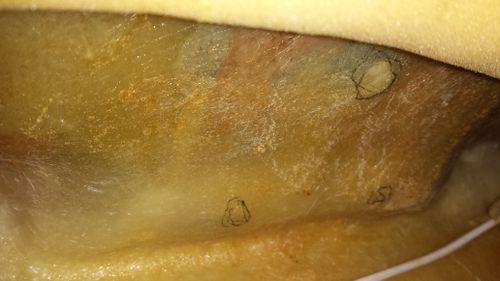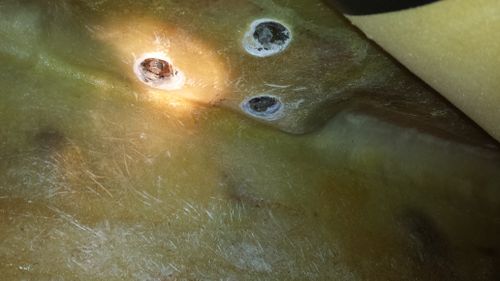Frozen Safety Rail Supports
This is a common problem which is usually due to the dissimilar metals eg retaining bolt is stainless and the base and stanchion are an aluminium alloy. The original Westerly stanchions were a very close fit to the base and become jammed very solidly after 30 years even without obvious corrosion. Using 25.0 stanchions in a 25.4 bore will give more latitude for release.
If your supports are not frozen look after them by removing them frequently and replacing them with a covering of grease or PTFE.
If you have frozen supports and you want to remove them say to make your winter cover sit flatter or if the bases are split proceed as follows:
First remove the supports from the boat.
This is not trivial because you will have to delve behind the side deck head lining and you will find that the bolts are glassed over.
The glass can be easily chopped away to expose the nut and washer which can then be removed. A neat way to expose the nuts is to use a small diameter hole saw with the drill retracted.
When you have the supports and base removed you can either replace both with new ones (see below) or take them back to a workshop to try to separate your original parts. This is difficult but not impossible. Proceed as follows: Don't rush it. Sit the seized ends in pot of diesel or paraffin or release/penetrating oil for as long as you can. The parts must be completely submerged in the release fluid. Then support the base in a decent vice with the stanchion vertically down, not nipping it too tightly. Get a large drift just small enough to penetrate the hole in the base about 3/4 inch dia. and using a 4 pound hammer give it a good belting. I removed two of them last week with no damage to either part.
Don't forget to drift or drill the retaining bolt first.
Tip: It may help to hit the stanchion from both directions. If you can get some movement either way it will eventually release.
Another experience: Using the method described above I have removed 4 out of 4 solidly seized stanchions from their bases. After completely submerging them in release oil for 2-3 weeks and using considerable hammer force I was able to tap (actually smash "smash") them backwards and forwards until finally they all separated. All four stanchions are useable but there is some cosmetic damage to the bases mainly where I had trouble drilling the stainless bolt out. I used a pillar drill and cobalt bits centre punched to locate but mostly the drill slipped off the stainless bolt into the soft alloy base so the hole ended up well over size. If you can drift out the bolt it is certainly preferable to drilling unless you have first class metal work facilities. It is possible to clean up the stanchions and the bases using a drum sanding pad.
Replacement with new bases The original bases manufactured for Gibb are out of production but are available parts from Allen with base holes within 0.5mm of the original ones.

